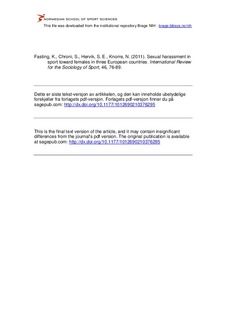| dc.contributor.author | Fasting, Kari | |
| dc.contributor.author | Chroni, Stilani | |
| dc.contributor.author | Hervik, Stein Egil | |
| dc.contributor.author | Knorre, Nada | |
| dc.date.accessioned | 2012-08-28T10:23:55Z | |
| dc.date.available | 2012-08-28T10:23:55Z | |
| dc.date.issued | 2011-03 | |
| dc.identifier | Seksjon for kultur og samfunn / Department of Cultural and Social Studies | |
| dc.identifier.citation | International Review for the Sociology of Sport. 2011, 46(1),76-89 | no_NO |
| dc.identifier.issn | 1461-7218 | |
| dc.identifier.issn | 1012-6902 | |
| dc.identifier.uri | http://hdl.handle.net/11250/170751 | |
| dc.description | I Brage finner du siste tekst-versjon av artikkelen, og den kan inneholde ubetydelige forskjeller fra forlagets pdf-versjon. Forlagets pdf-versjon finner du på www.sagepub.com: http://dx.doi.org/10.1177/1012690210376295 / In Brage you'll find the final text version of the article, and it may contain insignificant differences from the journal's pdf version. The original publication is available at www.sagepub.com: http://dx.doi.org/10.1177/1012690210376295 | no_NO |
| dc.description.abstract | This article presents data from a cross-cultural study titled ‘Gender Relations in Sport — The Experiences of Czech, Greek, and Norwegian Female Sport Students’. The main research question asked is: what are the amounts and the forms of male and female sexual harassment experienced in a sport setting by female sport students in Czech Republic, Greece, and Norway? Women (N = 616) who were studying in sport departments of academic institutions in the three countries participated in the study. The results show that 34 percent of the students had experienced sexually harassing behavior from a man and 12 percent from a woman. Experiences of sexually harassing behaviors from both men and women were reported more often in the Czech Republic and Greece than in Norway.The form of sexual harassment the participants reported experiencing the most was ‘repeated unwanted sexual glances, etc.’ (22%). The difference between female and male harassment is discussed in relation to patriarchal power. The overall differences between countries are discussed in relation to the three countries’ gender orders, gender equality laws as well as the anti-sexual harassment laws inside and outside sport organizations. | no_NO |
| dc.language.iso | eng | no_NO |
| dc.publisher | Sage | no_NO |
| dc.subject | cross-cultural study | no_NO |
| dc.subject | Europe | no_NO |
| dc.subject | sexual harassment | no_NO |
| dc.subject | sport | no_NO |
| dc.subject | women students | no_NO |
| dc.title | Sexual harassment in sport toward females in three European countries | no_NO |
| dc.type | Journal article | no_NO |
| dc.type | Peer reviewed | no_NO |
| dc.subject.nsi | VDP::Social science: 200::Social science in sports: 330::Other subjects within physical education: 339 | no_NO |
| dc.source.pagenumber | 76-89 | no_NO |
| dc.source.volume | 46 | no_NO |
| dc.source.journal | International Review for the Sociology of Sport | no_NO |
| dc.source.issue | 1 | no_NO |
